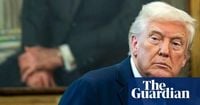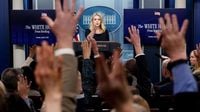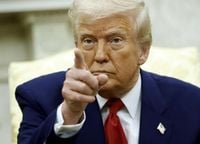On Tuesday, April 22, 2025, President Donald Trump signaled a potential easing of trade tensions between the United States and China, indicating that the steep tariffs on Chinese imports would be reduced. Speaking in the Oval Office following a swearing-in ceremony for Securities and Exchange Commission Chair Paul Atkins, Trump stated that the current 145 percent tax on most imported goods from China would come down as a result of ongoing trade negotiations. "The tariff on China will come down substantially," he asserted, though he clarified that it would not drop to zero.
During the news conference, Trump described the trade talks as "doing fine" and expressed optimism about the willingness of both U.S. and Chinese representatives to engage in constructive discussions. He emphasized that both sides would be "very nice" in their negotiations, but he maintained that China would ultimately have to agree to terms that would bring down the tariffs he has unilaterally imposed as part of his aggressive trade strategy. "Ultimately, they have to make a deal, because otherwise they're not going to be able to deal in the United States," Trump said. "We want them involved, but they have to, and other countries have to make a deal, and if they don't make a deal, we'll set the deal. We're going to be setting the deal, and it'll be a fair deal for everybody, and I think it's a process that's going to go pretty quickly."
Trump's comments come in the wake of a tumultuous period marked by his administration's imposition of high tariffs, which have rattled financial markets and raised concerns about a global economic downturn. In the past weeks, the stock market has experienced fluctuations due to fears surrounding the escalating trade war, which has seen retaliatory tariffs imposed by China, reaching up to 125 percent on U.S. goods.
White House Press Secretary Karoline Leavitt echoed Trump's sentiments, insisting that the entire world is eager to strike new bilateral trade deals with the U.S. as a result of the tariffs. "Everyone involved wants to see a trade deal happen," she stated during a briefing, highlighting the administration's reception of 18 proposals on paper from unspecified nations. However, she acknowledged that Trump's trade team had only met with representatives from 34 countries since Trump announced a temporary pause on the most severe tariffs.
Adding to the administration's optimistic outlook, Trump adviser Peter Navarro remarked in a televised interview earlier this month that the tariff policies could lead to 90 new trade deals during the three-month pause. Yet, despite these ambitious claims, no new agreements have been finalized or announced, raising questions about the administration's ability to deliver on its promises.
In a separate statement, Treasury Secretary Scott Bessent indicated that the high tariffs imposed by the Trump administration were unsustainable and anticipated a de-escalation in the trade war. "Neither side thinks the status quo is sustainable," Bessent noted, a sentiment that aligns with Trump's recent shift towards a more conciliatory approach in negotiations with China.
As the financial markets responded positively to Trump's reassurances, the S&P 500 stock index rose by 2.5 percent, reflecting investor optimism about a potential resolution to the trade conflict. Stocks rallied further in after-hours trading as Trump addressed the media, underscoring a growing belief that the administration's efforts could lead to a cooling of tensions.
Despite the upbeat tone, there remain significant hurdles to overcome. China's commerce ministry recently warned against any trade deals that may negatively impact its interests, emphasizing that it firmly opposes agreements reached at its expense. This caution highlights the delicate balance that both nations must navigate as they seek to resolve their differences.
In light of the ongoing negotiations, Trump has also urged the Federal Reserve to consider cutting interest rates, suggesting that he could fire Fed Chair Jerome Powell if necessary. However, he later clarified that he has no intention of dismissing Powell, instead expressing a desire for the Fed to act swiftly in lowering rates to support economic growth.
As the U.S. and China continue to engage in talks, the outcome remains uncertain. While Trump's recent comments suggest a willingness to compromise, the administration's track record raises questions about its ability to secure meaningful agreements that will benefit American workers and the economy as a whole. With both nations eager for a resolution, the coming weeks will be critical in determining the future of U.S.-China trade relations.
In conclusion, Trump's latest remarks reflect a significant shift in tone regarding trade negotiations with China, as he seeks to reassure investors and the public about the administration's commitment to finding a path forward. However, the complexities of the current trade landscape and the need for substantial agreements will undoubtedly pose challenges as both sides work towards a resolution.








